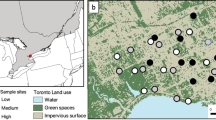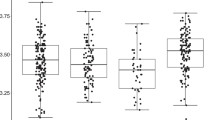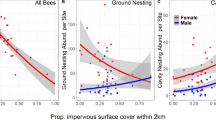Abstract
Urbanization is considered one of the major threats to biodiversity worldwide, with a special concern for native species decline, including wild bees. Through the increase of impervious surfaces, urbanization diminishes, fragments, and warms city environments, significantly reducing nesting and foraging resources for bees. Understanding the response of wildlife to urbanization in terms of reproduction, foraging efficiency, and offspring provisioning is important to species conservation in the face of continued urban development. In this study, we investigated how different levels of urbanization affect individual foraging effort, survival, brood productivity, and fitness in Ceratina calcarata. Our findings show that low urbanization levels favour larger-bodied adults, but foraging efforts (determined by wing wear) were higher at moderate disturbance levels. Larger-bodied mothers produced more numerous offspring (clutch size), mainly in medium disturbance sites. Likewise, larger-bodied mothers produced a larger-bodied offspring at low urbanization levels. Our results indicate that wild bees benefit from low and medium levels of urbanization indicated by maternal and offspring fitness in terms of body size and the number of brood, respectively. This suggests significant effects of urbanization on the fitness and stability of wild bee populations. This study provides novel insights into the impact of urban land use and highlights the importance of conserving and providing green spaces for pollinators.





Similar content being viewed by others
Data availability
Raw data that support the findings of this study are available upon request.
References
Ahrné K, Bengtsson J, Elmqvist T (2009) Bumble bees (Bombus spp) along a gradient of increasing urbanization. PloS One 4(5):e5574
Albrecht M, Duelli P, Schmid B, Mueller CB (2007) Interaction diversity within quantified insect food webs in restored and adjacent intensively managed meadows. J Anim Ecol 76(5):1015–1025
Arsenault SV, Hunt BG, Rehan SM (2018) The effect of maternal care on gene expression and DNA methylation in a subsocial bee. Nat Commun 9(1):1–9
Ayers AC, Rehan SM (2021) Supporting bees in cities: how bees are influenced by local and landscape features. Insects 12(2):128
Baldock KC, Goddard MA, Hicks DM, Kunin WE, Mitschunas N, Morse H, Memmott J (2019) A systems approach reveals urban pollinator hotspots and conservation opportunities. Nat Ecol Evol 3(3):363–373
Baldock KC, Goddard MA, Hicks DM, Kunin WE, Mitschunas N, Osgathorpe LM, Memmott J (2015) Where is the UK’s pollinator biodiversity? The importance of urban areas for flower-visiting insects. Proc Royal Soc B Biol Sci 282(1803):20142849
Banaszak-Cibicka W, Twerd L, Fliszkiewicz M, Giejdasz K, Langowska A (2018) City parks vs. natural areas-is it possible to preserve a natural level of bee richness and abundance in a city park? Urban Ecosyst 21(4):599–613
Bartomeus I, Ascher JS, Gibbs J, Danforth BN, Wagner DL, Hedtke SM, Winfree R (2013) Historical changes in northeastern US bee pollinators related to shared ecological traits. Proceedings of the National Academy of Sciences, 110(12), 4656–4660.
Bennett AB, Lovell S (2019) Landscape and local site variables differentially influence pollinators and pollination services in urban agricultural sites. PLoS One, 14(2):e0212034
Borowska J, Pyza E (2011) Effects of heavy metals on insect immunocompetent cells. J Insect Physiol 57(6):760–770
Bosch J, Vicens N (2002) Body size as an estimator of production costs in a solitary bee. Ecol Entomol 27(2):129–137
Bradley CA, Altizer S (2007) Urbanization and the ecology of wildlife diseases. Trends Ecol Evol 22(2):95–102
Brant RA, Arduser M, Dunlap AS (2022) There must bee a better way: a review of published urban bee literature and suggested topics for future study. Landsc Urban Plann 226:104513
Brasil SN, Ayers AC, Rehan SM (2023) The effect of urbanisation and seasonality on wild bee abundance, body size and foraging efforts. Ecologic Entomol 1–9
Buchholz S, Egerer MH (2020) Functional ecology of wild bees in cities: towards a better understanding of trait-urbanization relationships. Biodivers Conserv 29(9):2779–2801
Cardoso MC, Gonçalves RB (2018) Reduction by half: the impact on bees of 34 years of urbanization. Urban Ecosyst 21(5):943–949
Cartar RV (1992) Morphological senescence and longevity: an experiment relating wing wear and life span in foraging wild bumble bees. J Animal Ecol 225–231
Chole H, Woodard SH, Bloch G (2019) Body size variation in bees: regulation, mechanisms, and relationship to social organization. Curr Opin Insect Sci 35:77–87
Daly HV (1966) Biological studies on Ceratina dallatorreana, an alien bee in California which reproduces by parthenogenesis (Hymenoptera: Apoidea). Ann Entomol Soc Am 59(6):1138–1154
Ellis EC, Goldewijk K, Siebert K, Lightman S, Ramankutty N (2010) Anthropogenic transformation of the biomes, 1700 to 2000. Glob Ecol Biogeogr 19(5):589–606
Fahrig L (2017) Ecological responses to habitat fragmentation per se. Annual review of ecology, evolution, and systematics, 48:1–23
Ferrari A, Polidori C (2022) How city traits affect taxonomic and functional diversity of urban wild bee communities: insights from a worldwide analysis. Apidologie 53(4):1–23
Fitch G, Glaum P, Simao MC, Vaidya C, Matthijs J, Iuliano B, Perfecto I (2019) Changes in adult sex ratio in wild bee communities are linked to urbanization. Sci Rep 9(1):1–10
Fortel L, Henry M, Guilbaud L, Guirao AL, Kuhlmann M, Mouret H, …, Vaissière BE (2014) Decreasing abundance, increasing diversity and changing structure of the wild bee community (Hymenoptera: Anthophila) along an urbanization gradient. PLoS One 9(8):e104679
Foster DJ, Cartar RV (2011) What causes wing wear in foraging bumble bees? J Exp Biol 214(11):1896–1901
Geslin B, Le Féon V, Folschweiller M, Flacher F, Carmignac D, Motard E, …, Dajoz I (2016) The proportion of impervious surfaces at the landscape scale structures wild bee assemblages in a densely populated region. Ecol Evol 6(18):6599–6615
Goulson D, Whitehorn P, Fowley M (2012) Influence of urbanisation on the prevalence of protozoan parasites of bumblebees. Ecol Entomol 37(1):83–89
Greenleaf SS, Williams NM, Winfree R, Kremen C (2007) Bee foraging ranges and their relationship to body size. Oecologia 153(3):589–596
Grimm NB, Faeth SH, Golubiewski NE, Redman CL, Wu J, Bai X, Briggs JM (2008) Global change and the ecology of cities. Science 319(5864):756–760
Haas CA, Cartar RV (2008) Robust flight performance of bumble bees with artificially induced wing wear. Can J Zool 86(7):668–675
Hall DM, Camilo GR, Tonietto RK, Ollerton J, Ahrné K, Arduser M, Threlfall CG (2017) The city as a refuge for insect pollinators. Conserv Biol 31(1):24–29
Hamblin AL, Youngsteadt E, Frank SD (2018) Wild bee abundance declines with urban warming, regardless of floral density. Urban Ecosyst 21(3):419–428
Hamblin AL, Youngsteadt E, López-Uribe MM, Frank SD (2017) Physiological thermal limits predict differential responses of bees to urban heat-island effects. Biol Lett 13(6):20170125
Harrison T, Gibbs J, Winfree R (2019) Anthropogenic landscapes support fewer rare bee species. Landscape Ecol 34(5):967–978
Hernandez JL, Frankie GW, Thorp RW (2009) Ecology of urban bees: a review of current knowledge and directions for future study. Cities and the Environment (CATE), 2(1), 3. Insect Physiol 57(6)760–770
Hothorn T, Bretz F, Westfall P, Heiberger RM, Schuetzenmeister A, Scheibe S, Hothorn MT (2016) Package ‘multcomp’. Simultaneous inference in general parametric models. Project for Statistical Computing, Vienna, Austria
Kaluza BF, Wallace H, Heard TA, Klein AM, Leonhardt SD (2016) Urban gardens promote bee foraging over natural habitats and plantations. Ecol Evol 6(5):1304–1316
Kamm DR (1974) Effects of temperature, day length, and number of adults on the sizes of cells and offspring in a primitively social bee (Hymenoptera: Halictidae). J Kansas Entomol Soc 8–18
Kelemen EP, Rehan SM (2021) Opposing pressures of climate and land-use change on a native bee. Glob Change Biol 27(5):1017–1026
Kim JY (1999) Influence of resource level on maternal investment in a leaf-cutter bee (Hymenoptera: Megachilidae). Behav Ecol 10(5):552–556
Kleijn D, Winfree R, Bartomeus I, Carvalheiro LG, Henry M, Isaacs R, Potts SG (2015) Delivery of crop pollination services is an insufficient argument for wild pollinator conservation. Nat Commun 6(1):1–9
Kłysik K, Fortuniak K (1999) Temporal and spatial characteristics of the urban heat island of Łódź, Poland. Atmos Environ 33(24–25):3885–3895
Land Information Ontario (2019) Ontario Land Cover Compilation v.2.0. Available at: https://www.arcgis.com/home/item.html?id=7aa998fdf100434da27a41f1c637382c. Accessed 6 Aug 2022
Larson KL, Fleeger M, Lerman SB, Wheeler MM, Andrade R, Brown JA, Narango DL (2021) Who is abuzz about bees? Explaining residents’ attitudes in Phoenix, Arizona. Urban Ecosyst 24(1):35–48
Lawson SP, Ciaccio KN, Rehan SM (2016) Maternal manipulation of pollen provisions affects worker production in a small carpenter bee. Behav Ecol Sociobiol 70(11):1891–1900
López-Uribe MM, Oi CA, Del Lama MA (2008) Nectar-foraging behavior of Euglossine bees (Hymenoptera: Apidae) in urban areas. Apidologie 39(4):410–418
McCarthy MP, Best MJ, Betts RA (2010) Climate change in cities due to global warming and urban effects. Geophys Res Lett 37(9):L09705
McDonnell MJ, Hahs AK (2008) The use of gradient analysis studies in advancing our understanding of the ecology of urbanizing landscapes: current status and future directions. Landsc Ecol 23(10):1143–1155
Mikát M, Benda D, Straka J (2019) Maternal investment in a bee species with facultative nest guarding and males heavier than females. Ecol Entomol 44(6):823–832
Mikát M, Franchino C, Rehan SM (2017) Sociodemographic variation in foraging behavior and the adaptive significance of worker production in the facultatively social small carpenter bee, Ceratina calcarata. Behav Ecol Sociobiol 71(9):1–10
Mueller UG, Wolf-Mueller B (1993) A method for estimating the age of bees: age-dependent wing wear and coloration in the Wool-Carder bee Anthidium manicatum (hymenoptera: Megachilidae). J Insect Behav 6(4):529–537
Ne’eman G, Shavit O, Shaltiel L, Shmida A (2006) Foraging by male and female solitary bees with implications for pollination. J Insect Behav 19(3):383–401
Nooten SS, Rehan SM (2019) Agricultural land use yields reduced foraging efficiency and unviable offspring in the wild bee Ceratina calcarata. Ecol Entomol 44(4):534–542
O’Neill KM, Delphia CM, Pitts-Singer TL (2015) Seasonal trends in the condition of nesting females of a solitary bee: wing wear, lipid content, and oocyte size. PeerJ 3:e930
Potts SG, Biesmeijer JC, Kremen C, Neumann P, Schweiger O, Kunin WE (2010) Global pollinator declines: trends, impacts and drivers. Trends Ecol Evol 25(6):345–353
Prendergast KS, Dixon KW, Bateman PW (2021) Interactions between the introduced european honey bee and native bees in urban areas varies by year, habitat type and native bee guild. Biol J Linn Soc 133(3):725–743
Quezada-Euán JJG, López-Velasco A, Pérez-Balam J, Moo-Valle H, Velazquez-Madrazo A, Paxton RJ (2011) Body size differs in workers produced across time and is associated with variation in the quantity and composition of larval food in Nannotrigona perilampoides (Hymenoptera, Meliponini). Insectes Soc 58(1):31–38
R Core Team (2022) R: a language and environment for statistical computing. R Foundation for Statistical Computing, Vienna, Austria. https://www.r-project.org/
Rehan SM, Richards MH (2010) The influence of maternal quality on brood sex allocation in the small carpenter bee, Ceratina calcarata. Ethology 116(9):876–887
Rehan SM, Richards MH (2010a) Nesting biology and subsociality in Ceratina calcarata (Hymenoptera: Apidae). Can Entomol 142(1):65–74
Rehan SM, Richards MH, Adams M, Schwarz MP (2014) The costs and benefits of sociality in a facultatively social bee. Anim Behav 97:77–85
Renauld M, Hutchinson A, Loeb G, Poveda K, Connelly H (2016) Landscape simplification constrains adult size in a native ground-nesting bee. PLoS One 11(3):e0150946
Roberts JC, Cartar RV (2015) Shape of wing wear fails to affect load lifting in common eastern bumble bees (Bombus impatiens) with experimental wing wear. Can J Zool 93(7):531–537
Roberts SP, Harrison JF, Dudley R (2004) Allometry of kinematics and energetics in carpenter bees (Xylocopa varipuncta) hovering in variable-density gases. J Exp Biol 207(6):993–1004
Sakagami SF, Maeta Y (1977) Some presumably presocial habits of japanese Ceratina bees, with notes on various social types in Hymenoptera. Insectes Soc 24:319–343
Seidelmann K (2018) Optimal resource allocation, maternal investment, and body size in a solitary bee, Osmia bicornis. Entomol Exp Appl 166(9):790–799
Seto KC, Güneralp B, Hutyra LR (2012) Global forecasts of urban expansion to 2030 and direct impacts on biodiversity and carbon pools. Proc Natl Acad Sci 109(40):16083–16088
Shell WA, Rehan SM (2016) Recent and rapid diversification of the small carpenter bees in eastern North America. Biol J Linn Soc 117(3):633–645
Simkin RD, Seto KC, McDonald RI, Jetz W (2022) Biodiversity impacts and conservation implications of urban land expansion projected to 2050. Proc Natl Acad Sci 119(12):e2117297119
Sirohi MH, Jackson J, Edwards M, Ollerton J (2015) Diversity and abundance of solitary and primitively eusocial bees in an urban centre: a case study from Northampton (England). J Insect Conserv 19(3):487–500
Statistics Canada (2016) Toronto [Census metropolitan area], Ontario and Ontario [Province] (table). Census Profile. 2016 Census. Statistics Canada Catalogue no. 98-316-X2016001. Ottawa. Released November 29, 2017. https://www12.statcan.gc.ca/census-recensement/2016/dp-pd/prof/index.cfm?Lang=E. Accessed 14 Aug 2022
Svensson JR, Lindegarth M, Jonsson PR, Pavia H (2012) Disturbance–diversity models: what do they really predict and how are they tested?. Proceedings of the Royal Society B: Biological Sciences, 279(1736), 2163–2170.
Tepedino VJ, Torchio PF (1982) Phenotypic variability in nesting success among Osmia lignaria propinqua females in a glasshouse environment:(Hymenoptera: Megachilidae). Ecol Entomol 7(4):453–462
Threlfall CG, Walker K, Williams NS, Hahs AK, Mata L, Stork N, Livesley SJ (2015) The conservation value of urban green space habitats for australian native bee communities. Biol Conserv 187:240–248
United Nations (2018) Revision of world urbanization prospects, vol 799. United Nations
Vance JT, Roberts SP (2014) The effects of artificial wing wear on the flight capacity of the honeybee Apis mellifera. J Insect Physiol 65:27–36
Westphal C, Steffan-Dewenter I, Tscharntke T (2006) Bumblebees experience landscapes at different spatial scales: possible implications for coexistence. Oecologia 149(2):289–300
Wickham H, Chang W, Wickham MH (2016) Package ‘ggplot2.’ Create elegant data visualisations using the grammar of graphics Version 2(1):1–189
Wignall VR, Harry C, Davies I, Kenny NL, McMinn SD, Ratnieks FL (2020) Seasonal variation in exploitative competition between honeybees and bumblebees. Oecologia 192(2):351–361
Wilson CJ, Jamieson MA (2019) The effects of urbanization on bee communities depends on floral resource availability and bee functional traits. PLoS One 14(12):e0225852
Youngsteadt E, Appler RH, López-Uribe MM, Tarpy DR, Frank SD (2015) Urbanization increases pathogen pressure on feral and managed honey bees. PloS One 10(11):e0142031
Zipper SC, Schatz J, Kucharik CJ, Loheide SP (2017) Urban heat island-induced increases in evapotranspirative demand. Geophys Res Lett 44(2):873–881
Zurbuchen A, Cheesman S, Klaiber J, Müller A, Hein S, Dorn S (2010) Long foraging distances impose high costs on offspring production in solitary bees. J Anim Ecol 79(3):674–681
Zurbuchen A, Landert L, Klaiber J, Müller A, Hein S, Dorn S (2010) Maximum foraging ranges in solitary bees: only few individuals have the capability to cover long foraging distances. Biol Conserv 143(3):669–676
Acknowledgements
We thank members of the Rehan lab for providing valuable feedback on earlier versions of this manuscript. Thanks to Mariam Shamekh and Phuong Nguyen for assistance with nest dissections and processing of bee specimens.
Funding
Funding for this study was provided by NSERC Discovery grants, supplements, and an E.W.R. Steacie Memorial Fellowship to SMR.
Author information
Authors and Affiliations
Contributions
ACA, JLH and MMRK performed material preparation and data collection. SNRB, MMRK and SMR performed data analysis. SNRB and SMR wrote the manuscript. SMR conceived and funded the study. All authors reviewed the manuscript.
Corresponding author
Ethics declarations
Conflict of interests
The authors declare no competing interests.
Additional information
Publisher’s Note
Springer Nature remains neutral with regard to jurisdictional claims in published maps and institutional affiliations.
Rights and permissions
Springer Nature or its licensor (e.g. a society or other partner) holds exclusive rights to this article under a publishing agreement with the author(s) or other rightsholder(s); author self-archiving of the accepted manuscript version of this article is solely governed by the terms of such publishing agreement and applicable law.
About this article
Cite this article
Brasil, S.N.R., Khair, M., Ayers, A.C. et al. Urban landscapes affect wild bee maternal investment and body size. Urban Ecosyst 26, 1319–1329 (2023). https://doi.org/10.1007/s11252-023-01378-0
Accepted:
Published:
Issue Date:
DOI: https://doi.org/10.1007/s11252-023-01378-0




